Time river theory, the nile decoded
Page 1 of 1
 Time river theory, the nile decoded
Time river theory, the nile decoded
]Hints of Intelligent Design
Shown below is an overview map of the Nile in Africa, the world’s longest river. This is the ancient river that gave rise to the mysterious ancient Egyptian civilization thousands of years ago.

And here are the initial clues hinting at the existence of intelligence behind the river’s layout:

1.
The Nile is distinctively vertical (longitudinal), and it is the only notable river on this planet to flow directly northward.
2.
The Nile begins at the equator and disintegrates precisely at 30°N latitude, marked by Egypt’s capital Cairo and Giza, the home of the great pyramids and the Sphinx.[1]
3.
The generally straight Nile makes a dramatic turn southward near the halfway point. The northern peak of this remarkable bend – sometimes referred to as the ‘Great Bend’ – pinpoints latitude 19.5°N.
The significance of #3 comes from the fact that 19.5° is considered a ‘tetrahedral constant’, deriving from the geometric configuration of a circumscribed tetrahedron shown below.

In terms of the ‘hyperdimensional physics’ model promoted by researcher Richard Hoagland, well known for his investigation into the ‘monuments of Mars’, the angle even represents an inter-dimensional ‘gateway’ of some sort. This notion is echoed by the great pyramids at Giza - a place traditionally signifying a 'gateway' (Rostau) - in that their layout prominently produces this very angle.
The fact that the longitude pinpointed by the same Bend’s peak is 33.0°E intensifies our curiosity as ‘33’ too happens to be a key number detected by Hoagland’s team (The Enterprise Mission).
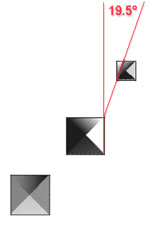
ndeed, 19.5 and 33 are said to be the two ‘ritual numbers’ repeatedly encoded into various aspects of NASA space missions.
In 1997, for example, the Pathfinder space probe landed on Mars at almost exactly 19.5°N. 33°W. That this was no coincidence is evidenced by the fact that: 1) the lander dropped on the ‘tetrahedral latitude’ was tetrahedral in shape; and 2) at the moment of touchdown, Earth was positioned 19.5° above the eastern Martian horizon as seen from the landing site.
As Mike Bara, Hoagland’s right-hand man at the Enterprise Mission, wrote:
Pathfinder’s unique tetrahedral spacecraft design geometry, coupled with the totally “recursive” tetrahedral geometry of the landing site itself, was obviously intended by NASA “ritualists” behind the scenes to celebrate – on their first return to Mars in over twenty years – the two key Hyperdimensional numbers underlying all the NASA rituals – “19.5” and “33.”[2]
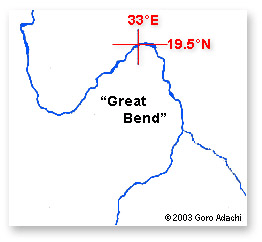
ndeed, 19.5 and 33 are said to be the two ‘ritual numbers’ repeatedly encoded into various aspects of NASA space missions.
In 1997, for example, the Pathfinder space probe landed on Mars at almost exactly 19.5°N. 33°W. That this was no coincidence is evidenced by the fact that: 1) the lander dropped on the ‘tetrahedral latitude’ was tetrahedral in shape; and 2) at the moment of touchdown, Earth was positioned 19.5° above the eastern Martian horizon as seen from the landing site.
As Mike Bara, Hoagland’s right-hand man at the Enterprise Mission, wrote:
Pathfinder’s unique tetrahedral spacecraft design geometry, coupled with the totally “recursive” tetrahedral geometry of the landing site itself, was obviously intended by NASA “ritualists” behind the scenes to celebrate – on their first return to Mars in over twenty years – the two key Hyperdimensional numbers underlying all the NASA rituals – “19.5” and “33.”[2]
Whether or not NASA intentionally conducts such ‘rituals’ is still a contentious issue, of course. But the coincidence of the two numbers is difficult to ignore. Where there is smoke, as they say, there is usually fire.
So how should we interpret these geographical hints provided by the Nile? Are we to believe that the Nile is a 'monument' carrying some sort of message?
While admittedly a wild speculation, this is certainly not the first time such an idea has been put forward. There is, for example, researcher Livio Catullo Stecchini, whose view is presented in Peter Tompkin’s Secrets of the Great Pyramid:
The Egyptians were proud that their country had some unique geographic features which could be expressed in rigorous geometric terms and had a shape which related to the order of the cosmos as they saw it. They believed that when the gods created the cosmos they began by building Egypt and, having created it perfect, modeled the rest around it. …[The] Egyptians put great stress also on the geographic peculiarities of the course of the Nile.[3]
So the question is: Are these Nilotic ‘peculiarities’ a result of some deliberate design? Did the ‘gods’ literally construct the Nile and encode into its layout their cosmic knowledge?
Throughout history much has been said about ancient monuments - such as those at Giza (the pyramids and Sphinx) - bearing very advanced knowledge surpassing all that came afterward. It is of course a controversial view that many find uncomfortable. But it pales in comparison to the much crazier possibility emerging here... that the world’s longest river, clearly visible from space, may be a gigantic ‘monument’!
A Literal ‘River of Time’?
Suspending our disbelief for a moment, let us ponder just what the encoded ‘cosmic knowledge’ may be. What kind of information could be so important as to be transmitted this way?
This question leads us to the next clue.
As noted earlier, the latitudinal length of the Nile is almost exactly 30 degrees. The number ‘30’ happens to be closely attached to the notion of time:
* Saturn, traditionally considered the god/planet of time, has an orbital period of ~30 years.[4]
* One month – the Moon’s orbit around Earth – is approximately 30 days. (In ancient Egypt, each month was exactly 30 days.)
* The apparent path of the sun in the sky (the ecliptic) is traditionally divided into twelve zodiacal ‘signs’ (Pisces, Aires, Taurus, etc.), 30 degrees each, corresponding to the sun’s movement in two hours. (The Babylonians, the Chinese, etc. actually divided the day into not 24 but 12 equal parts, and so one subdivision of the day corresponded to 30 degrees [i.e. 360/12=30].)
* The seb festival of the ancient Egyptians, commemorating the symbolic death/renewal of the king, was held in the 30th year of the reign.[5]
So the implication here is that the Nile is to be viewed as a ‘river of time’. This is poetically appealing at least. After all, it is often said that ‘a river is like the flow of time’
The above interpretation is reinforced by certain information transmitted by Plutarch, a renowned Greek writer and biographer from around AD 100. It concerns Saturn, the god of time, who was called ‘Cronus’ in Greek (related to the term ‘Chronos’ meaning ‘time’[7]):
There is also a religious lament sung over Cronus. The lament is for him that is born in the regions of the left, and suffers dissolution in the regions on the right; for the Egyptians believe that the eastern regions are the face of the world, the northern the right, and the southern to the left. The Nile, therefore, which runs from the south and is swallowed up by the sea in the north, is naturally said to have its birth on the left and its dissolution on the right.[8]
Not only does Plutarch reveal here that Cronus/time arises in the south and ends in the north just like the Nile, he even goes on to draw a direct parallel between Cronus/time and the Nile! This is almost an open and direct acknowledgement that the Nile may indeed represent the flow of time.
God of Time, God of the Nile
Another telling clue is found in the fact that various mythological gods associated with time are also often associated with the Nile. For instance:
* Cronus-Saturn’s otherworldly domain called Ogygia is applicable to the Nile since the river was similarly called ‘Ogygian’ by the ancient Greek writer Aeschylus.[9]
* The Moon, associated with the ‘temporal number’ 30 via its orbital period (30 days), is traditionally identified with the Egyptian god of wisdom called Thoth. Not only was Thoth considered the measurer of time, he was also represented by the ibis, an animal closely associated with the Nile.[10]
More striking is Osiris, the most revered and complex deity in ancient Egypt, popularly described as the god of the dead.
Osiris is quite simply the ‘god of the Nile’. This can be established through his traditional identification with Apis and Hapi, both considered to embody the Nile. Osiris was also known as Serapis, a name deriving from Ausar-Hapi, meaning ‘Osiris of the Nile’. We also have Herodotus’ well-known statement: ‘the Nile is the gift of Osiris, but Egypt is the gift of the Nile’.
And we find that Osiris, the god of the Nile, is also a god of time not unlike Saturn. Osiris was identified with the phoenix, the mythical fire-bird of cyclical rebirth and the patron of all time division.[11] In the ancient Egyptian Book of the Dead is found the statement: ‘I am Time and Osiris’.[12] And in ancient India the name given to Orion (the celestial form of Osiris) was Kal-Purush, or ‘Time Man’.[13]
To all intents and purposes, Osiris is the Egyptian version of Cronus-Saturn, the god of time.[14] In confirmation of this, historical epithets of Orion (= Osiris) include ‘Saturnus’ – i.e. Saturn.[15]
So, at least mythologically, the Nile-time connection is well supported.
...continued from Page 1
Giza Producing ‘Anchor Dates’
If the Nile really is a literal river of time – a ‘Time River’ – then the possibility must be considered that there is a tangible timeline encoded into its design. And it can be reasonably assumed that the river’s beginning point at the equator represents the earliest point on the timeline, and Giza/Cairo at the edge (30°N) the ‘end of time’. (See Appendix 1 for discussion on the beginning latitude of the Nile.)
The most sensible time-encoding system here would be one based on latitude, where a linear, northward-moving timeline is superimpose on the Nile.
To derive a timeline in this system, it is necessary to first have at least two ‘anchor points’, or 'anchor dates', placed upon the Nile. The rest would be just a matter of simple calculation. (The distance between the two anchor points will have the function of a base unit for the timeline.) But there needs to be a good rationale for selecting these points/dates.
For this, we turn to the Giza monuments, evidently an integral part of the Nile scheme (marking the river’s northern edge). Giza, through its astronomical alignments, manages to give us just what we need to turn the ancient river into a tangible map of time.
The key here is Robert Bauval’s popular ‘Orion Correlation Theory’ (or more broadly the ‘Star Correlation Theory’) which traces the Giza layout back to the stars. The basic idea is quite simple. The theory essentially says that the arrangement of the three great pyramids standing there closely emulates that of the three Belt Stars of Orion, the heavenly Osiris.
Bauval demonstrates this first by noting that the smallest pyramid is slightly offset from the diagonal line made by the other two pyramids. He then compares this to a similar offset seen in the Orion Belt Stars, with the dimmest star congruently corresponding to the smallest pyramid.
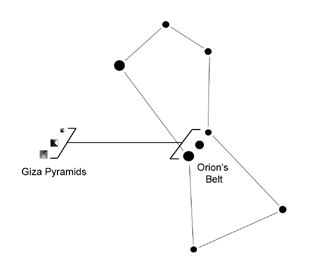
This sky-ground correspondence is supported by a passage from the ancient Egyptian ‘Pyramid Texts’ which makes it plain that the pyramid and Osiris-Orion are closely linked:
O Horus, this King is Osiris [= Orion], this pyramid of the King is Osiris, this construction of his is Osiris; betake yourself to it, do not be far from it in its name of ‘Pyramid’…[16]
Next, based on this initial ‘as above, so below’ connection, Bauval points out that there was an extraordinary set of alignments around 10,500 BC:
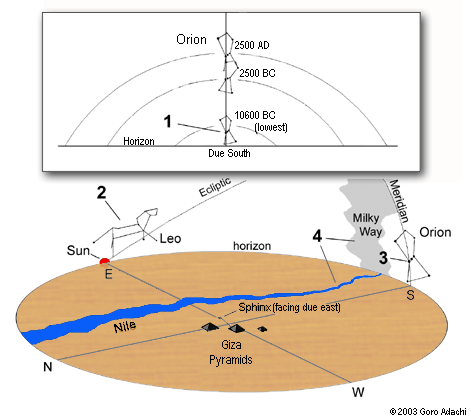
Around 10,500 BC:
1. Orion reached its lowest point at the meridian in its 26,000-year precessional cycle. (Precession slowly shifts Orion and other stars up and down the meridian, the imaginary north-south line drawn in the sky where the stars achieve their highest daily altitudes.)
2. On the vernal equinox, the Great Sphinx, directly facing east, witnessed the rising of its two celestial counterparts – the sun and Leo.
At the moment of equinoctial sunrise (c. 10,500 BC):
3.
Orion was positioned right at the meridian.
4.
In the southern sky, the Milky Way was seen roughly vertical and positioned in such a way that it appeared to be an extension of the Nile. Orion was situated just to the right of the celestial river – closely mimicking the configuration of the Giza pyramids and the Nile.
It is reasonable to conclude that the builders of the Giza monuments intended to commemorate the extremely ancient epoch of 10,500 BC.
We can refine the date by taking a closer look at Point #1, i.e. Orion’s lowest transit point (‘southern culmination’). It occurred more exactly c. 10,600 BC. This, then, is our first ‘anchor date’.
As for the second ‘anchor date’, the answer turns out to be the ‘Pyramid Age’ when the pyramids themselves were built - around 2500 BC.
The date can be refined through another Giza celestial alignment, this time involving the four ‘air shafts’ (or 'star shafts') emanating from the so-called King’s Chamber and Queen’s Chamber inside the Great Pyramid.
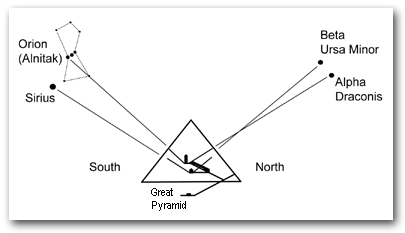
Expanding on the theory of Alexander Badawy and Virginia Trimble,[17] Bauval found that these shafts, targeted at the meridian (i.e. due south/north), are angled just right so that around 2400 BC they aligned with key stars crossing the meridian ('transit'). The southern shafts were aimed at Alnitak (of Orion) and Sirius; the northern ones were aimed at Beta Ursa Minor (‘Kochab’) and Alpha Draconis (‘Thuban’, the ancient Pole Star).
Bauval claims that these alignments collectively pinpoint c. 2450 BC, but this is not quite accurate. It should be more like c. 2350 BC. All the star-shaft alignments occurred at the latter time except for Orion’s alignment with the King’s Chamber southern shaft (c. 2490 BC). But as Dr. Thomas G. Brophy points out, the same shaft did come into alignment with the Galactic Center around 2350 BC.[18]
At this point, then, the Giza monuments have given us two solid anchor dates, 10,600 BC and 2350 BC.
A Timeline Emerges
The next step is to figure out where to place these anchor dates along the Nile.
For 10,600 BC, it is actually a simple matter. Since the ‘10,500 BC epoch’ appears to signify the mythical ‘First Time’ (Zep Tepi), as postulated by Bauval and Hancock, it would naturally go to the source of the Nile at the equator. It is where ‘time’ begins, as the Nile flows out of Lake Victoria. In support of this designation, we find that the same epoch also happens to mark the establishment of the Nile’s equatorial Lake Victoria outlet.[19]
Additionally, the usage of the equator as the beginning latitude is strongly encouraged by Giza’s 10,600 BC celestial alignment. Let us examine it again:

1.
Orion was positioned due south and as close to the horizon as possible, thus guiding our attention toward the southernmost source of the Nile (Lake Victoria) situated due south of Giza.
2.
Point 1 was accompanied by the equinoctial sunrise with Leo due east. Since the equinoxes are when the sun is at the extension of the equator (called the ‘celestial equator’), it tells us that 10,600 BC is to be seen as an equatorial (anchor) date.
As for the 2350 BC anchor date, we can assume that it will go to one of the following key points on the Nile: 1) the confluence at Khartoum, 2) the Atbara confluence, 3) the Great Bend peak, or 4) Giza/Cairo. The question is: Which one?
A big clue here comes from Sirius and Orion’s Alnitak, two prominent stars from the Great Pyramid's star-alignment scheme. They happened to produce the angle 19.5° around 2350 BC.
When Sirius was rising at the horizon as viewed from Giza, Alnitak we seen hovering 19.5° above the horizon. (See illustration below.)
This suggests that the date 2350 BC and the angle/latitude 19.5° are to be united. Hence we are encouraged to assign the second anchor date to the Great Bend’s peak at 19.5°.
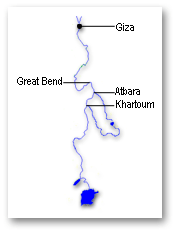

There are other clues supporting the arrangement - including the fact that the general region of the Great Bend (Nubia/Kush) was once called the ‘Land of the Bow’ (Ta-Seti), which strongly resonates with the ‘Sirian’ nature of the 2350 BC-19.5°N anchor point, because Sirius’ various epithets happen to include ‘Bow Star’ (as well as ‘Arrow Star’).
So, with the two anchor points firmly established, we are now ready to move on to the critical step - the conversion of Nilotic latitudes into dates.[20]
As the highlights below show, what emerges is a startling timeline:
* Khartoum at 15.60°N. corresponds precisely to 4000 BC.
* The Atbara-Nile confluence at 17.67°N. corresponds to 3124 BC.
* Giza/Cairo at 30.00°N. corresponds to AD 2093.
For those familiar with the general outline of ancient history, the significance of the first two dates, 4000 BC and c. 3100 BC, should be immediately clear. The third date c. AD 2100 is intriguing too for its close proximity to our own time.
For those not very familiar with ancient chronology, 4000 BC is in various ways – historically, religiously, and esoterically – the ‘beginning of the world’:
* It was around 4000 BC that the first known high civilization called Sumer suddenly rose in Mesopotamia (present Iraq) to begin ‘history’.
* The year 4004 BC is the standard Christian date for Adam, the first man, based on the scriptural calculation done by Archbishop James Ussher in the mid-seventeenth century (Annales Veteris Testamenti). In his calculation, Ussher even applied the date 2348 BC to the Great Flood, which almost exactly matches one of our anchor dates (2350 BC)!
* 4000 BC is the beginning date used in the calendar adopted by Freemasonry – a quasi-esoteric fraternal organization whose enigmatic tradition can be traced back to various ancient cultures, including ancient Egypt. (Remarkably, the highest rank in Scottish Freemasonry is called ‘33rd Degree’ as if in reference to the key Nilotic longitude, 33°E.)
The other ancient date pinpointed, c. 3100 BC, has similar implications:
* The date coincides with the beginning of ancient Egypt – none other than the ‘gift of the Nile’ itself! It was indeed around 3100 BC that King Menes commenced the Dynastic period as he unified Lower Egypt and Upper Egypt – an event known as the ‘Unification of the Two Lands’.
* The date coincides with what the Mayan calendar calls the ‘Birth of Venus’ (3114 BC), the beginning of the current age.[21]
* For the Hindus, too, c. 3100 BC was the beginning of the present age called Kali Yuga.[22]
It is quite evident that the Nile Timeline is very meaningful.
Now, before moving on to the next step, let us divide up the Nile according to the zodiacal Ages, each lasting roughly 2160 years. (We are currently living near the end of the 'Age of Pisces' and about to move into the 'Age of Aquarius'.) The illustration below shows the Nile so rendered.
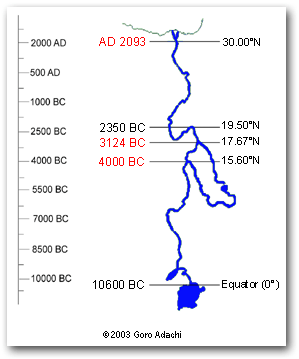

We see that the river covers exactly six Ages – Leo, Cancer, Gemini, Taurus, Aries, and Pisces. Notice that the middle section around the Great Bend corresponds to the Age of Taurus. This will be shown to have a profound implication shortly.
....the rest at
http://www.goroadachi.com/timerivers/niledecoded-p3.htm
Shown below is an overview map of the Nile in Africa, the world’s longest river. This is the ancient river that gave rise to the mysterious ancient Egyptian civilization thousands of years ago.

And here are the initial clues hinting at the existence of intelligence behind the river’s layout:

1.
The Nile is distinctively vertical (longitudinal), and it is the only notable river on this planet to flow directly northward.
2.
The Nile begins at the equator and disintegrates precisely at 30°N latitude, marked by Egypt’s capital Cairo and Giza, the home of the great pyramids and the Sphinx.[1]
3.
The generally straight Nile makes a dramatic turn southward near the halfway point. The northern peak of this remarkable bend – sometimes referred to as the ‘Great Bend’ – pinpoints latitude 19.5°N.
The significance of #3 comes from the fact that 19.5° is considered a ‘tetrahedral constant’, deriving from the geometric configuration of a circumscribed tetrahedron shown below.

In terms of the ‘hyperdimensional physics’ model promoted by researcher Richard Hoagland, well known for his investigation into the ‘monuments of Mars’, the angle even represents an inter-dimensional ‘gateway’ of some sort. This notion is echoed by the great pyramids at Giza - a place traditionally signifying a 'gateway' (Rostau) - in that their layout prominently produces this very angle.
The fact that the longitude pinpointed by the same Bend’s peak is 33.0°E intensifies our curiosity as ‘33’ too happens to be a key number detected by Hoagland’s team (The Enterprise Mission).

ndeed, 19.5 and 33 are said to be the two ‘ritual numbers’ repeatedly encoded into various aspects of NASA space missions.
In 1997, for example, the Pathfinder space probe landed on Mars at almost exactly 19.5°N. 33°W. That this was no coincidence is evidenced by the fact that: 1) the lander dropped on the ‘tetrahedral latitude’ was tetrahedral in shape; and 2) at the moment of touchdown, Earth was positioned 19.5° above the eastern Martian horizon as seen from the landing site.
As Mike Bara, Hoagland’s right-hand man at the Enterprise Mission, wrote:
Pathfinder’s unique tetrahedral spacecraft design geometry, coupled with the totally “recursive” tetrahedral geometry of the landing site itself, was obviously intended by NASA “ritualists” behind the scenes to celebrate – on their first return to Mars in over twenty years – the two key Hyperdimensional numbers underlying all the NASA rituals – “19.5” and “33.”[2]

ndeed, 19.5 and 33 are said to be the two ‘ritual numbers’ repeatedly encoded into various aspects of NASA space missions.
In 1997, for example, the Pathfinder space probe landed on Mars at almost exactly 19.5°N. 33°W. That this was no coincidence is evidenced by the fact that: 1) the lander dropped on the ‘tetrahedral latitude’ was tetrahedral in shape; and 2) at the moment of touchdown, Earth was positioned 19.5° above the eastern Martian horizon as seen from the landing site.
As Mike Bara, Hoagland’s right-hand man at the Enterprise Mission, wrote:
Pathfinder’s unique tetrahedral spacecraft design geometry, coupled with the totally “recursive” tetrahedral geometry of the landing site itself, was obviously intended by NASA “ritualists” behind the scenes to celebrate – on their first return to Mars in over twenty years – the two key Hyperdimensional numbers underlying all the NASA rituals – “19.5” and “33.”[2]
Whether or not NASA intentionally conducts such ‘rituals’ is still a contentious issue, of course. But the coincidence of the two numbers is difficult to ignore. Where there is smoke, as they say, there is usually fire.
So how should we interpret these geographical hints provided by the Nile? Are we to believe that the Nile is a 'monument' carrying some sort of message?
While admittedly a wild speculation, this is certainly not the first time such an idea has been put forward. There is, for example, researcher Livio Catullo Stecchini, whose view is presented in Peter Tompkin’s Secrets of the Great Pyramid:
The Egyptians were proud that their country had some unique geographic features which could be expressed in rigorous geometric terms and had a shape which related to the order of the cosmos as they saw it. They believed that when the gods created the cosmos they began by building Egypt and, having created it perfect, modeled the rest around it. …[The] Egyptians put great stress also on the geographic peculiarities of the course of the Nile.[3]
So the question is: Are these Nilotic ‘peculiarities’ a result of some deliberate design? Did the ‘gods’ literally construct the Nile and encode into its layout their cosmic knowledge?
Throughout history much has been said about ancient monuments - such as those at Giza (the pyramids and Sphinx) - bearing very advanced knowledge surpassing all that came afterward. It is of course a controversial view that many find uncomfortable. But it pales in comparison to the much crazier possibility emerging here... that the world’s longest river, clearly visible from space, may be a gigantic ‘monument’!
A Literal ‘River of Time’?
Suspending our disbelief for a moment, let us ponder just what the encoded ‘cosmic knowledge’ may be. What kind of information could be so important as to be transmitted this way?
This question leads us to the next clue.
As noted earlier, the latitudinal length of the Nile is almost exactly 30 degrees. The number ‘30’ happens to be closely attached to the notion of time:
* Saturn, traditionally considered the god/planet of time, has an orbital period of ~30 years.[4]
* One month – the Moon’s orbit around Earth – is approximately 30 days. (In ancient Egypt, each month was exactly 30 days.)
* The apparent path of the sun in the sky (the ecliptic) is traditionally divided into twelve zodiacal ‘signs’ (Pisces, Aires, Taurus, etc.), 30 degrees each, corresponding to the sun’s movement in two hours. (The Babylonians, the Chinese, etc. actually divided the day into not 24 but 12 equal parts, and so one subdivision of the day corresponded to 30 degrees [i.e. 360/12=30].)
* The seb festival of the ancient Egyptians, commemorating the symbolic death/renewal of the king, was held in the 30th year of the reign.[5]
So the implication here is that the Nile is to be viewed as a ‘river of time’. This is poetically appealing at least. After all, it is often said that ‘a river is like the flow of time’
The above interpretation is reinforced by certain information transmitted by Plutarch, a renowned Greek writer and biographer from around AD 100. It concerns Saturn, the god of time, who was called ‘Cronus’ in Greek (related to the term ‘Chronos’ meaning ‘time’[7]):
There is also a religious lament sung over Cronus. The lament is for him that is born in the regions of the left, and suffers dissolution in the regions on the right; for the Egyptians believe that the eastern regions are the face of the world, the northern the right, and the southern to the left. The Nile, therefore, which runs from the south and is swallowed up by the sea in the north, is naturally said to have its birth on the left and its dissolution on the right.[8]
Not only does Plutarch reveal here that Cronus/time arises in the south and ends in the north just like the Nile, he even goes on to draw a direct parallel between Cronus/time and the Nile! This is almost an open and direct acknowledgement that the Nile may indeed represent the flow of time.
God of Time, God of the Nile
Another telling clue is found in the fact that various mythological gods associated with time are also often associated with the Nile. For instance:
* Cronus-Saturn’s otherworldly domain called Ogygia is applicable to the Nile since the river was similarly called ‘Ogygian’ by the ancient Greek writer Aeschylus.[9]
* The Moon, associated with the ‘temporal number’ 30 via its orbital period (30 days), is traditionally identified with the Egyptian god of wisdom called Thoth. Not only was Thoth considered the measurer of time, he was also represented by the ibis, an animal closely associated with the Nile.[10]
More striking is Osiris, the most revered and complex deity in ancient Egypt, popularly described as the god of the dead.
Osiris is quite simply the ‘god of the Nile’. This can be established through his traditional identification with Apis and Hapi, both considered to embody the Nile. Osiris was also known as Serapis, a name deriving from Ausar-Hapi, meaning ‘Osiris of the Nile’. We also have Herodotus’ well-known statement: ‘the Nile is the gift of Osiris, but Egypt is the gift of the Nile’.
And we find that Osiris, the god of the Nile, is also a god of time not unlike Saturn. Osiris was identified with the phoenix, the mythical fire-bird of cyclical rebirth and the patron of all time division.[11] In the ancient Egyptian Book of the Dead is found the statement: ‘I am Time and Osiris’.[12] And in ancient India the name given to Orion (the celestial form of Osiris) was Kal-Purush, or ‘Time Man’.[13]
To all intents and purposes, Osiris is the Egyptian version of Cronus-Saturn, the god of time.[14] In confirmation of this, historical epithets of Orion (= Osiris) include ‘Saturnus’ – i.e. Saturn.[15]
So, at least mythologically, the Nile-time connection is well supported.
...continued from Page 1
Giza Producing ‘Anchor Dates’
If the Nile really is a literal river of time – a ‘Time River’ – then the possibility must be considered that there is a tangible timeline encoded into its design. And it can be reasonably assumed that the river’s beginning point at the equator represents the earliest point on the timeline, and Giza/Cairo at the edge (30°N) the ‘end of time’. (See Appendix 1 for discussion on the beginning latitude of the Nile.)
The most sensible time-encoding system here would be one based on latitude, where a linear, northward-moving timeline is superimpose on the Nile.
To derive a timeline in this system, it is necessary to first have at least two ‘anchor points’, or 'anchor dates', placed upon the Nile. The rest would be just a matter of simple calculation. (The distance between the two anchor points will have the function of a base unit for the timeline.) But there needs to be a good rationale for selecting these points/dates.
For this, we turn to the Giza monuments, evidently an integral part of the Nile scheme (marking the river’s northern edge). Giza, through its astronomical alignments, manages to give us just what we need to turn the ancient river into a tangible map of time.
The key here is Robert Bauval’s popular ‘Orion Correlation Theory’ (or more broadly the ‘Star Correlation Theory’) which traces the Giza layout back to the stars. The basic idea is quite simple. The theory essentially says that the arrangement of the three great pyramids standing there closely emulates that of the three Belt Stars of Orion, the heavenly Osiris.
Bauval demonstrates this first by noting that the smallest pyramid is slightly offset from the diagonal line made by the other two pyramids. He then compares this to a similar offset seen in the Orion Belt Stars, with the dimmest star congruently corresponding to the smallest pyramid.

This sky-ground correspondence is supported by a passage from the ancient Egyptian ‘Pyramid Texts’ which makes it plain that the pyramid and Osiris-Orion are closely linked:
O Horus, this King is Osiris [= Orion], this pyramid of the King is Osiris, this construction of his is Osiris; betake yourself to it, do not be far from it in its name of ‘Pyramid’…[16]
Next, based on this initial ‘as above, so below’ connection, Bauval points out that there was an extraordinary set of alignments around 10,500 BC:

Around 10,500 BC:
1. Orion reached its lowest point at the meridian in its 26,000-year precessional cycle. (Precession slowly shifts Orion and other stars up and down the meridian, the imaginary north-south line drawn in the sky where the stars achieve their highest daily altitudes.)
2. On the vernal equinox, the Great Sphinx, directly facing east, witnessed the rising of its two celestial counterparts – the sun and Leo.
At the moment of equinoctial sunrise (c. 10,500 BC):
3.
Orion was positioned right at the meridian.
4.
In the southern sky, the Milky Way was seen roughly vertical and positioned in such a way that it appeared to be an extension of the Nile. Orion was situated just to the right of the celestial river – closely mimicking the configuration of the Giza pyramids and the Nile.
It is reasonable to conclude that the builders of the Giza monuments intended to commemorate the extremely ancient epoch of 10,500 BC.
We can refine the date by taking a closer look at Point #1, i.e. Orion’s lowest transit point (‘southern culmination’). It occurred more exactly c. 10,600 BC. This, then, is our first ‘anchor date’.
As for the second ‘anchor date’, the answer turns out to be the ‘Pyramid Age’ when the pyramids themselves were built - around 2500 BC.
The date can be refined through another Giza celestial alignment, this time involving the four ‘air shafts’ (or 'star shafts') emanating from the so-called King’s Chamber and Queen’s Chamber inside the Great Pyramid.

Expanding on the theory of Alexander Badawy and Virginia Trimble,[17] Bauval found that these shafts, targeted at the meridian (i.e. due south/north), are angled just right so that around 2400 BC they aligned with key stars crossing the meridian ('transit'). The southern shafts were aimed at Alnitak (of Orion) and Sirius; the northern ones were aimed at Beta Ursa Minor (‘Kochab’) and Alpha Draconis (‘Thuban’, the ancient Pole Star).
Bauval claims that these alignments collectively pinpoint c. 2450 BC, but this is not quite accurate. It should be more like c. 2350 BC. All the star-shaft alignments occurred at the latter time except for Orion’s alignment with the King’s Chamber southern shaft (c. 2490 BC). But as Dr. Thomas G. Brophy points out, the same shaft did come into alignment with the Galactic Center around 2350 BC.[18]
At this point, then, the Giza monuments have given us two solid anchor dates, 10,600 BC and 2350 BC.
A Timeline Emerges
The next step is to figure out where to place these anchor dates along the Nile.
For 10,600 BC, it is actually a simple matter. Since the ‘10,500 BC epoch’ appears to signify the mythical ‘First Time’ (Zep Tepi), as postulated by Bauval and Hancock, it would naturally go to the source of the Nile at the equator. It is where ‘time’ begins, as the Nile flows out of Lake Victoria. In support of this designation, we find that the same epoch also happens to mark the establishment of the Nile’s equatorial Lake Victoria outlet.[19]
Additionally, the usage of the equator as the beginning latitude is strongly encouraged by Giza’s 10,600 BC celestial alignment. Let us examine it again:

1.
Orion was positioned due south and as close to the horizon as possible, thus guiding our attention toward the southernmost source of the Nile (Lake Victoria) situated due south of Giza.
2.
Point 1 was accompanied by the equinoctial sunrise with Leo due east. Since the equinoxes are when the sun is at the extension of the equator (called the ‘celestial equator’), it tells us that 10,600 BC is to be seen as an equatorial (anchor) date.
As for the 2350 BC anchor date, we can assume that it will go to one of the following key points on the Nile: 1) the confluence at Khartoum, 2) the Atbara confluence, 3) the Great Bend peak, or 4) Giza/Cairo. The question is: Which one?
A big clue here comes from Sirius and Orion’s Alnitak, two prominent stars from the Great Pyramid's star-alignment scheme. They happened to produce the angle 19.5° around 2350 BC.
When Sirius was rising at the horizon as viewed from Giza, Alnitak we seen hovering 19.5° above the horizon. (See illustration below.)
This suggests that the date 2350 BC and the angle/latitude 19.5° are to be united. Hence we are encouraged to assign the second anchor date to the Great Bend’s peak at 19.5°.


There are other clues supporting the arrangement - including the fact that the general region of the Great Bend (Nubia/Kush) was once called the ‘Land of the Bow’ (Ta-Seti), which strongly resonates with the ‘Sirian’ nature of the 2350 BC-19.5°N anchor point, because Sirius’ various epithets happen to include ‘Bow Star’ (as well as ‘Arrow Star’).
So, with the two anchor points firmly established, we are now ready to move on to the critical step - the conversion of Nilotic latitudes into dates.[20]
As the highlights below show, what emerges is a startling timeline:
* Khartoum at 15.60°N. corresponds precisely to 4000 BC.
* The Atbara-Nile confluence at 17.67°N. corresponds to 3124 BC.
* Giza/Cairo at 30.00°N. corresponds to AD 2093.
For those familiar with the general outline of ancient history, the significance of the first two dates, 4000 BC and c. 3100 BC, should be immediately clear. The third date c. AD 2100 is intriguing too for its close proximity to our own time.
For those not very familiar with ancient chronology, 4000 BC is in various ways – historically, religiously, and esoterically – the ‘beginning of the world’:
* It was around 4000 BC that the first known high civilization called Sumer suddenly rose in Mesopotamia (present Iraq) to begin ‘history’.
* The year 4004 BC is the standard Christian date for Adam, the first man, based on the scriptural calculation done by Archbishop James Ussher in the mid-seventeenth century (Annales Veteris Testamenti). In his calculation, Ussher even applied the date 2348 BC to the Great Flood, which almost exactly matches one of our anchor dates (2350 BC)!
* 4000 BC is the beginning date used in the calendar adopted by Freemasonry – a quasi-esoteric fraternal organization whose enigmatic tradition can be traced back to various ancient cultures, including ancient Egypt. (Remarkably, the highest rank in Scottish Freemasonry is called ‘33rd Degree’ as if in reference to the key Nilotic longitude, 33°E.)
The other ancient date pinpointed, c. 3100 BC, has similar implications:
* The date coincides with the beginning of ancient Egypt – none other than the ‘gift of the Nile’ itself! It was indeed around 3100 BC that King Menes commenced the Dynastic period as he unified Lower Egypt and Upper Egypt – an event known as the ‘Unification of the Two Lands’.
* The date coincides with what the Mayan calendar calls the ‘Birth of Venus’ (3114 BC), the beginning of the current age.[21]
* For the Hindus, too, c. 3100 BC was the beginning of the present age called Kali Yuga.[22]
It is quite evident that the Nile Timeline is very meaningful.
Now, before moving on to the next step, let us divide up the Nile according to the zodiacal Ages, each lasting roughly 2160 years. (We are currently living near the end of the 'Age of Pisces' and about to move into the 'Age of Aquarius'.) The illustration below shows the Nile so rendered.


We see that the river covers exactly six Ages – Leo, Cancer, Gemini, Taurus, Aries, and Pisces. Notice that the middle section around the Great Bend corresponds to the Age of Taurus. This will be shown to have a profound implication shortly.
....the rest at
http://www.goroadachi.com/timerivers/niledecoded-p3.htm

highnoon- Posts : 567
Join date : 2009-11-18
Age : 38
 Similar topics
Similar topics» It's Picture Time...
» Structures in Time and Space
» Time to Reconsider Facebook
» The Sinkhole of Schmalkalden and the Omens of Time
» Jan. 7, 2010 Golden Ratio Discovered in Quantum World: Hidden Symmetry Observed for the First Time in Solid State Matter
» Structures in Time and Space
» Time to Reconsider Facebook
» The Sinkhole of Schmalkalden and the Omens of Time
» Jan. 7, 2010 Golden Ratio Discovered in Quantum World: Hidden Symmetry Observed for the First Time in Solid State Matter
Page 1 of 1
Permissions in this forum:
You cannot reply to topics in this forum